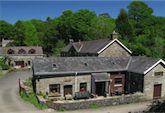Sweep back through Welsh history to find out what the Romans did for Wales, on a visit to the amphitheatre and baths at Caerleon, or what they took from Wales at the Dolaucothi gold mines. Explore Wales, the fortified kingdom of castles – some whole, some ruined, or travel back to when coal was king and mining and smelting left a thick fog of pollution and hills of slag up and down the industrial valleys, when Cardiff’s port was one of the world’s busiest.
Wales may be a tiny country, but it has hundreds of castles, with one of the highest concentrations of medieval fortifications in Europe. The biggest and best in the south Wales is in Caerphilly – the second largest castle in Britain, covering over 30 acres with a impressive moat. Slapped in the middle of the now-town centre, take a look at the gravity-defying leaning tower, and the machines of war including the giant catapult, or Trebuchet, which still works. Perhaps your visit may coincide with historical re-enactments. Britain’s first stone castle is thought to be in Chepstow, built a year after the Norman Conquest of 1066. It marked the end of rough-and-ready earth and timber strongholds – and a major change in castle design.
Wales’ now-clean valleys may now seem free from any coal mining legacy, but the small valley town Blaenavon owes its Unesco World Heritage status to its past. As one of only fifteen Unesco sites in the world, it joins Hadrian’s Wall, Stonehenge and Canterbury Cathedral. Its old ironworks and coal mine are open to visitors, who can imagine they are coal miners descending to the depths of the earth at The Big Pit – exactly what it says it is – a massive mile-deep hole in the ground.
The “Fairest Abbey in all Wales” is in Neath, founded in 1130 by Baron Richard de Granville. You can visit it on your way out of Neath, and view it lit up at night on your way home. You’ll feel like a monk, armed with the huge cartoon-like key to open the door.
Pendine Sands is flat, sandy and very very long. The six mile-long beach is famous for speed and there is a Museum of Speed in Pendine. Land speed record attempts were made there in the 1920s. Sir Malcolm Campbell broke the world record driving Blue Bird at over 170mph and the first non-stop flight across the Atlantic (from Britain to the USA) took off here. The flight, by Amy Johnson and Jim Mollison, left Pendine Sands in July 1933 and took 34 hours.
For a huge collection of historical buildings from all over Wales in one place – visit the National History Museum (formerly the Museum of Welsh Life), where historical Welsh buildings of importance come to retire. All over the country buildings typical of their area or era are carefully dismantled and rebuilt in the 50 acres surrounding St Fagans Castle, a 1580s country house, making it one of Europe’s largest open-air museums.
Everyone knows about Welsh dragons, but what about the dungeons? Castell Carreg Cennen is the most romantically poised castle in Wales, balanced on a rocky outcrop, in the middle of green patchwork fields. Take your torch down to the natural cave underneath, used to keep prisoners.
Some of our favourite Welsh history websites are Gathering The Jewles where you will find over 20,000 images of objects, books, letters, aerial photographs and other items relating to Welsh cultural history and Castles of Wales, the definitive guide to Welsh castles.





